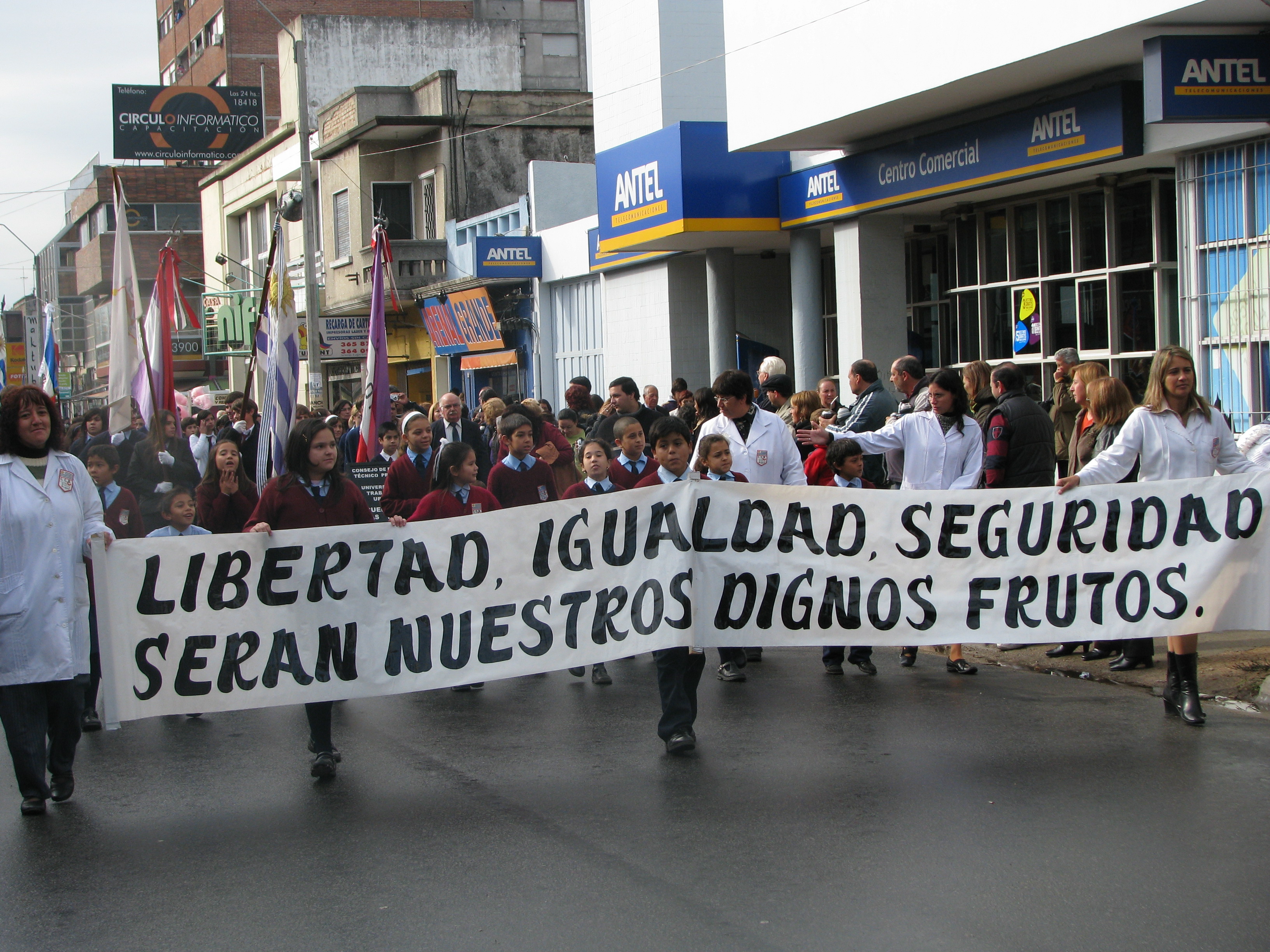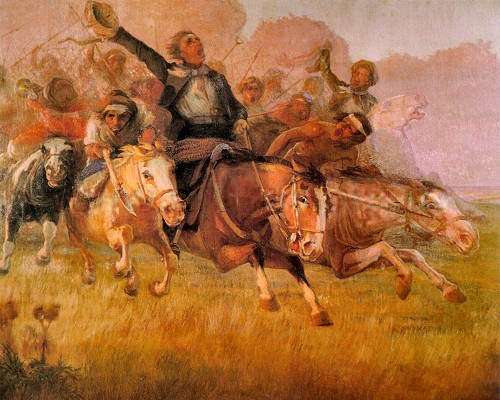|
Artiguism
Artiguism is the set of political ideas, economic and social, of José Gervasio Artigas, the main leader of the Oriental Revolution held in the Oriental Province of the United Provinces of the Río de la Plata, which was a predecessor of the modern Republic of Uruguay. Sources of Inspiration Artiguism has two main sources: the works of American authors such as Thomas Paine (supporters of federalism) and the French authors of the Enlightenment as Jean-Jacques Rousseau. Artigas read books in his teens as "''Common Sense''" by Paine and "''The Social Contract''" by Rousseau. As such, the first "Caudillo" or Founding Father of the La Plata territory seems to have been inspired more by the English enlightenment than the French. The ideology of Artigas is partially taken from the U.S. legal texts. American political liberalism exerted strong influence him. Other Hispanic independence leaders, however, were more influenced by the French Revolution and the authors of France. Some histori ... [...More Info...] [...Related Items...] OR: [Wikipedia] [Google] [Baidu] |
José Gervasio Artigas
José Gervasio Artigas Arnal (; June 19, 1764 – September 23, 1850) was a political leader, military general, statesman and national hero of Uruguay and the broader Río de la Plata region. He fought in the Latin American wars of independence against the Spanish Empire, but also against the Portuguese Empire and the centralist government of Buenos Aires in the pursuit of political and civil liberties for the peoples of the Viceroyalty of the Río de la Plata. He is considered a ''Libertador'' of Latin America and a national hero in Uruguay, sometimes referred to as "the father of Uruguayan nationhood". His biggest political project was the creation of the Federal League, a confederation of South American provinces under a federal style of government inspired by the United States. Biography Early life Artigas was born in Montevideo on June 19, 1764. His grandparents were from Zaragoza, Buenos Aires and Tenerife (Canary Islands). His grandparents fought in the War ... [...More Info...] [...Related Items...] OR: [Wikipedia] [Google] [Baidu] |
History Of Uruguay
The history of Uruguay comprises different periods: the pre-Columbian time or early history (up to the 16th century), the Colonial Period (1516–1811), the Period of Nation-Building (1811–1830), and the history of Uruguay as an independent country (1830). Native The earliest traces of human presence are about 10,000 years old and belong to the hunter-gatherer cultures of Catalanense and Cuareim cultures, which are extensions of cultures originating in Brazil. The earliest discovered bolas is about 7,000 years old. Examples of ancient rock art have been found at Chamangá. About 4,000 years ago, Charrúa and Guarani people arrived here. During precolonial times, Uruguayan territory was inhabited by small tribes of nomadic Charrúa, Chaná, Arachán, and Guarani peoples who survived by hunting and fishing and probably never reached more than 10,000 to 20,000 people. It is estimated that there were about 9,000 Charrúa and 6,000 Chaná and Guaraní at the time of first con ... [...More Info...] [...Related Items...] OR: [Wikipedia] [Google] [Baidu] |
Instructions Of The Year XIII
The Instructions of the Year XIII ( es, Instrucciones del año XIII) were the mandate brought by the representatives from the Oriental Province to the Assembly of the Year XIII of the United Provinces of the River Plate. In 1813, a meeting called by the Second Triumvirate was meant to define the type of government for the new nation. The people of the Oriental Province (what is now Uruguay) drafted a federalist document, opposed to the centralism of the Second Triumvirate. Among other ideas, the following principles were proclaimed: * independence, * republic, * federalism, * full civic and religious freedom, * the capital should not be Buenos Aires. These Instructions were the origin of an unending conflict between the Oriental leader, José Gervasio Artigas, and the authorities that be in Buenos Aires. Some scholars see the influence of American founding father Thomas Paine in these Instructions.John Street, ''Artigas and the Emancipation of Uruguay'' (London: Cambridge Univer ... [...More Info...] [...Related Items...] OR: [Wikipedia] [Google] [Baidu] |
Eponymous Political Ideologies
An eponym is a person, a place, or a thing after whom or which someone or something is, or is believed to be, named. The adjectives which are derived from the word eponym include ''eponymous'' and ''eponymic''. Usage of the word The term ''eponym'' functions in multiple related ways, all based on an explicit relationship between two named things. A person, place, or thing named after a particular person share an eponymous relationship. In this way, Elizabeth I of England is the eponym of the Elizabethan era. When Henry Ford is referred to as "the ''eponymous'' founder of the Ford Motor Company", his surname "Ford" serves as the eponym. The term also refers to the title character of a fictional work (such as Rocky Balboa of the ''Rocky'' film series), as well as to ''self-titled'' works named after their creators (such as the album ''The Doors'' by the band the Doors). Walt Disney created the eponymous Walt Disney Company, with his name similarly extended to theme parks such as ... [...More Info...] [...Related Items...] OR: [Wikipedia] [Google] [Baidu] |
Political Movements In Uruguay
Politics (from , ) is the set of activities that are associated with making decisions in groups, or other forms of power relations among individuals, such as the distribution of resources or status. The branch of social science that studies politics and government is referred to as political science. It may be used positively in the context of a "political solution" which is compromising and nonviolent, or descriptively as "the art or science of government", but also often carries a negative connotation.. The concept has been defined in various ways, and different approaches have fundamentally differing views on whether it should be used extensively or limitedly, empirically or normatively, and on whether conflict or co-operation is more essential to it. A variety of methods are deployed in politics, which include promoting one's own political views among people, negotiation with other political subjects, making laws, and exercising internal and external force, including w ... [...More Info...] [...Related Items...] OR: [Wikipedia] [Google] [Baidu] |
Colonia Del Sacramento
, settlement_type = Capital city , image_skyline = Basilica del Sanctísimo Sacramento.jpg , imagesize = , image_caption = Basílica del Santísimo Sacramento , pushpin_map = Uruguay , subdivision_type = Country , subdivision_name = , subdivision_type1 = Department , subdivision_name1 = , established_title = Founded , established_date = 1680 , founder = Manuel Lobo , population_as_of = 2011 Census , population_total = 26231 , population_density_km2 = , area_total_km2 = , timezone = UTC -3 , coordinates = , elevation_m = 27 , postal_code_type = Postal code , postal_code = 70000 , area_code_type = Dial plan , area_code = +598 452 (+5 digits) , blank_name = Climate , blank_info = Cfa , website = https://www.colonia.gub.uy/ , footnotes = Colonia ... [...More Info...] [...Related Items...] OR: [Wikipedia] [Google] [Baidu] |
Free Trade
Free trade is a trade policy that does not restrict imports or exports. It can also be understood as the free market idea applied to international trade. In government, free trade is predominantly advocated by political parties that hold economically liberal positions, while economic nationalist and left-wing political parties generally support protectionism, the opposite of free trade. Most nations are today members of the World Trade Organization multilateral trade agreements. Free trade was best exemplified by the unilateral stance of Great Britain who reduced regulations and duties on imports and exports from the mid-nineteenth century to the 1920s. An alternative approach, of creating free trade areas between groups of countries by agreement, such as that of the European Economic Area and the Mercosur open markets, creates a protectionist barrier between that free trade area and the rest of the world. Most governments still impose some protectionist policies that are inte ... [...More Info...] [...Related Items...] OR: [Wikipedia] [Google] [Baidu] |
Constitution
A constitution is the aggregate of fundamental principles or established precedents that constitute the legal basis of a polity, organisation or other type of Legal entity, entity and commonly determine how that entity is to be governed. When these principles are written down into a single document or set of legal documents, those documents may be said to embody a ''written constitution''; if they are encompassed in a single comprehensive document, it is said to embody a ''codified constitution''. The Constitution of the United Kingdom is a notable example of an ''uncodified constitution''; it is instead written in numerous fundamental Acts of a legislature, court cases or treaties. Constitutions concern different levels of organizations, from Sovereign state, sovereign countries to Company, companies and unincorporated Club (organization), associations. A treaty which establishes an international organization is also its constitution, in that it would define how that organiza ... [...More Info...] [...Related Items...] OR: [Wikipedia] [Google] [Baidu] |
Viceroyalty Of The Río De La Plata
The Viceroyalty of the Río de la Plata ( es, Virreinato del Río de la Plata or es, Virreinato de las Provincias del Río de la Plata) meaning "River of the Silver", also called "Viceroyalty of the River Plate" in some scholarly writings, in southern South America, was the last to be organized and also the shortest-lived of the Viceroyalties of the Spanish Empire in the Americas. The name ''"Provincias del Río de la Plata"'' was formally adopted in 1810 during the Cortes of Cádiz to designate the Viceroyalty of the Río de la Plata The Viceroyalty was established in 1776 from several former Viceroyalty of Perú dependencies that mainly extended over the Río de la Plata Basin, roughly the present-day territories of Argentina, Chile, Bolivia, Paraguay and Uruguay, extending inland from the Atlantic Coast. The colony of Spanish Guinea (present-day Equatorial Guinea) also depended administratively on the Viceroyalty of Rio de la Plata. Buenos Aires, located on the western sho ... [...More Info...] [...Related Items...] OR: [Wikipedia] [Google] [Baidu] |
Banda Oriental
Banda Oriental, or more fully Banda Oriental del Uruguay (Eastern Bank), was the name of the South American territories east of the Uruguay River and north of Río de la Plata that comprise the modern nation of Uruguay; the modern state of Rio Grande do Sul, Brazil; and some of the modern state of Santa Catarina, Brazil. It was the easternmost territory of the Viceroyalty of the Río de la Plata. After decades of disputes over the territories, the 1777 First Treaty of San Ildefonso settled the division between the Spanish Empire and the Portuguese Empire: the southern part was to be held by the Spanish Viceroyalty of the Río de la Plata and the northern territories by the Portuguese ''Capitania de São Pedro do Rio Grande do Sul'' ( en, Captaincy of Saint Peter of the Southern Río Grande). The Banda Oriental was not a separate administrative unit until the ''de facto'' creation of the Provincia Oriental ( en, Eastern Province) by José Gervasio Artigas in 1813 and the subsequen ... [...More Info...] [...Related Items...] OR: [Wikipedia] [Google] [Baidu] |





.jpg)

